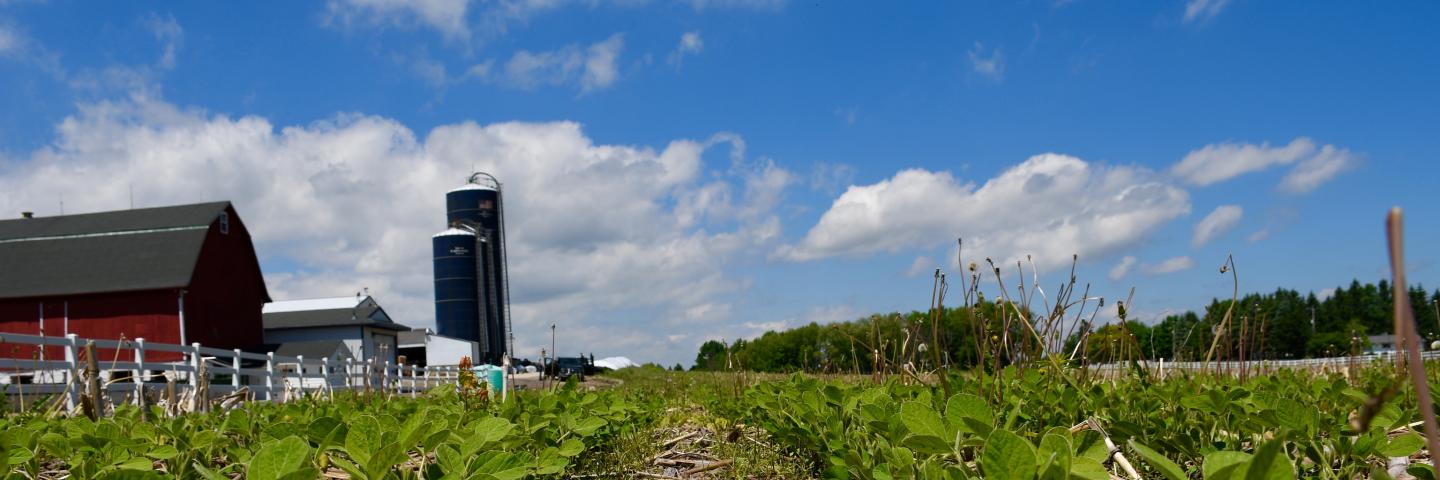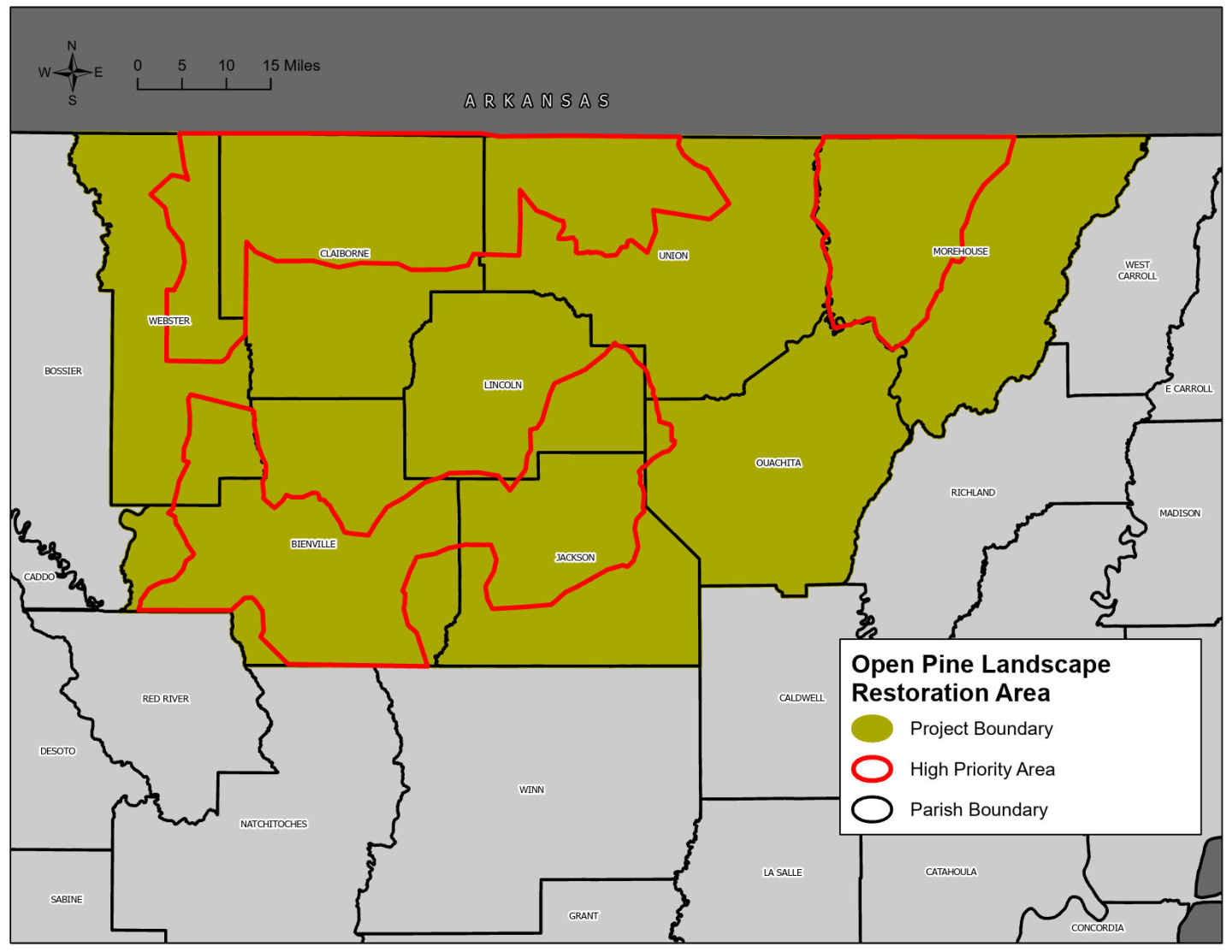
The Regional Conservation Partnership Program (RCPP) is a partner-driven approach to conservation that funds solutions to natural resource challenges on agricultural land.
FY24 RCPP Signups by Project
January 15 - February 13, 2024
Louisiana RCPP Overview
The Regional Conservation Partnership Program (RCPP) promotes coordination of NRCS conservation activities with partners that offer value-added contributions to expand our collective ability to address on-farm, watershed, and regional natural resource concerns. Through RCPP, NRCS seeks to co-invest with partners to implement projects that demonstrate innovative solutions to conservation challenges and provide measurable improvements and outcomes tied to the resource concerns they seek to address.
There are two types of national funding announcements under RCPP.
- RCPP Classic is the standard version of the program where NRCS and the lead partner both oversee contracts with producers and landowners engaged in RCPP activities.
- RCPP Alternative Funding Arrangements (AFA) are partner-led projects that propose innovative use of federal assistance to achieve conservation benefits that are not possible under the RCPP Classic construct.

RCPP Conservation Activities
RCPP projects may include a range of on-the-ground conservation activities implemented by farmers, ranchers and forest landowners. These activities include:
- Land management/land improvement/restoration practices
- Land rentals
- Entity-held easements
- United States-held easements
- Public works/watersheds
A single RCPP project application can propose to employ any combination of these eligible activity types as part of an RCPP project. For more details about eligible RCPP conservation activities, please see the RCPP funding announcement. The State of Louisiana, also known as the Bayou and Pelican State is known for its vast areas of coastal marsh, swamp lands and wet savannas that are the homes of many birds such as the Ibises, Egrets, the Louisiana State bird - the Brown Pelican and the Louisiana’s famous Bald Cypress Tree -Taxodium distichum. In Louisiana’s more elevated landscape is home of the longleaf pine forests and many varieties of protected animal and plant species such as the red-cockaded woodpecker, Louisiana Pine Snake and the Short-Leaf Pine Tree.
Louisiana RCPP Projects List
Open Pine Landscape Restoration: #2319
Lead Partner Organization: American Bird Conservancy (ABC)
Lead State: Arkansas
Project Start and End Years: 2021 - 2026
Primary Conservation Focus:
- Terrestrial Habitat Concerns
- State Action Plan species: Northern Bobwhite, Eastern Wild Turkey, Brown-headed Nuthatch, Henslow’s and LeConte’s sparrows
- Federally Listed and at-risk priority Louisiana Pine Snake, Red-cockaded Woodpecker, Frosted Elfin and Monarch Butterfly.
- Fire Management
- Water Quality

Project Summary: Arkansas -Louisiana Conservation Delivery Network (CDN) Open Pine Landscape Restoration goals are to greatly improve Forest Health for Wildlife Resources in the West Gulf Coastal Plains/Ouachita (WGCPO). The project will connect and build upon ABC’s successful programs in other landscapes across the United States. This RCPP brings together many partners working together toward a common goal.
Partners, such as the Lower Mississippi Valley Joint Venture (LMVJV) CDN will enable advance the recovery of species using our Desired Forest Conditions (DFC) management practices for the open pine habitat. Implementation of Integrated Vegetation Management (IVM) treatments that connect public and private land will increase the overall conversation impacts – restoring over 60,000 acres of landscape for the next 10-20 years. With 30,000 acres by forestland producers and an additional 30,000 acres of other private and public connected habitats.
Improving Water Quality Using Practices 590 RCPP: #2134
Lead Partner Organization: Ducks Unlimited, Inc.
Lead State: Louisiana
Project Start and End Years: 2020 - 2025
Primary Conservation Focus:
- Field Sediment, Nutrient, Pathogen Loss
- Nutrient Management to advance water quality improvements.
Project Summary: Numerous studies have found sediment and nutrient loadings from agricultural lands to be a major contributor to the Gulfs hypoxic zone as well as local stream and river degradation. Nutrient loss from agriculture and other sources, particularly nitrogen and phosphorous, is contributing to over-enrichment of waterways, and not to mention loss of nutrients is an added cost to producers. It is estimated that fewer of southwest Louisiana rice producers apply nutrients following recommendations for an up-to-date soil test and fewer than 5% of those are using precision application of nutrients. Even within precision application of nutrients, there is a range of technology. Those who attempt grid soil sampling and precision application quickly sees the benefits and further adopt the practice.

Conjunctive Water Use Protects Mid-South Aquifers: #2779
Lead Partner Organization: Ducks Unlimited, Inc.
State Partners: Arkansas and Mississippi
Project Start and End Years: 2023 - 2028
Project Summary: Conjunctive water use is the coordinated use of ground and surface water resources. Ducks Unlimited and more than 10 partners plan to help farmers
implement practices and systems that increase the availability of surface water resources for irrigation while increasing irrigation efficiency, with the aim of reducing dependency on dwindling Mid-South aquifers. Project partners will offer additional technical and financial assistance to participating producers, including the Arkansas Department of Agriculture which offers State tax credits to producers who improve on-farm water storage water to surface water sources for irrigation. The project will also realize climate benefits with the conversion of up to 250 farms from diesel to electric irrigation systems.

For more information:
https://nrcs.maps.arcgis.com/apps/Shortlist/index.html?appid=ab6aa86f9a…
Mid-South Graduated Water Stewardship Program: #2274
Lead Partner Organization: USA Rice Federation
Lead State: Arkansas
Project Start and End Years: 2020 - 2025
Primary Conservation Focus:
- Source Water Depletion
- Terrestrial Habitat Concerns
- Inefficient Energy Usage
- Field sediment, nutrient and pathogen loss
Project Summary: The economically distressed Lower Mississippi River Valley Region of the United States has longed been impacted by decades of excessive annual withdrawals of its aquifer. The Mississippi River Alluvial Aquifer has been in an uphill battle to maintain its ability to retain groundwater levels, improve its water quality and provide a sustainable habitat for a vast variety of wildlife.
The Mississippi River Alluvial Aquifer also serves as a vital and valuable irrigation source for rice farmers. The severely declining water levels that threaten the entire region viability could result in regulation for framers. To address this, USA Rice Federation along with its partnered Ducks Unlimited and more than 20 other partners within this RCPPP target all levels of producers, from those who are just beginning their conservation efforts, to those who are advanced in their conservation practices.
Louisiana has two Funding Categories – Northeast LA Zone and Central LA Zone.

Ready to get started?
Contact your local service center to start your application.
How to Get Assistance
Do you farm or ranch and want to make improvements to the land that you own or lease?
Natural Resources Conservation Service offers technical and financial assistance to help farmers, ranchers and forest landowners.

To get started with NRCS, we recommend you stop by your local NRCS field office. We’ll discuss your vision for your land.
NRCS provides landowners with free technical assistance, or advice, for their land. Common technical assistance includes: resource assessment, practice design and resource monitoring. Your conservation planner will help you determine if financial assistance is right for you.
We’ll walk you through the application process. To get started on applying for financial assistance, we’ll work with you:
- To fill out an AD 1026, which ensures a conservation plan is in place before lands with highly erodible soils are farmed. It also ensures that identified wetland areas are protected.
- To meet other eligibility certifications.
Once complete, we’ll work with you on the application, or CPA 1200.
Applications for most programs are accepted on a continuous basis, but they’re considered for funding in different ranking periods. Be sure to ask your local NRCS district conservationist about the deadline for the ranking period to ensure you turn in your application in time.
As part of the application process, we’ll check to see if you are eligible. To do this, you’ll need to bring:
- An official tax ID (Social Security number or an employer ID)
- A property deed or lease agreement to show you have control of the property; and
- A farm number.
If you don’t have a farm number, you can get one from USDA’s Farm Service Agency. Typically, the local FSA office is located in the same building as the local NRCS office. You only need a farm number if you’re interested in financial assistance.
NRCS will take a look at the applications and rank them according to local resource concerns, the amount of conservation benefits the work will provide and the needs of applicants. View Application Ranking Dates by State.
If you’re selected, you can choose whether to sign the contract for the work to be done.
Once you sign the contract, you’ll be provided standards and specifications for completing the practice or practices, and then you will have a specified amount of time to implement. Once the work is implemented and inspected, you’ll be paid the rate of compensation for the work if it meets NRCS standards and specifications.

